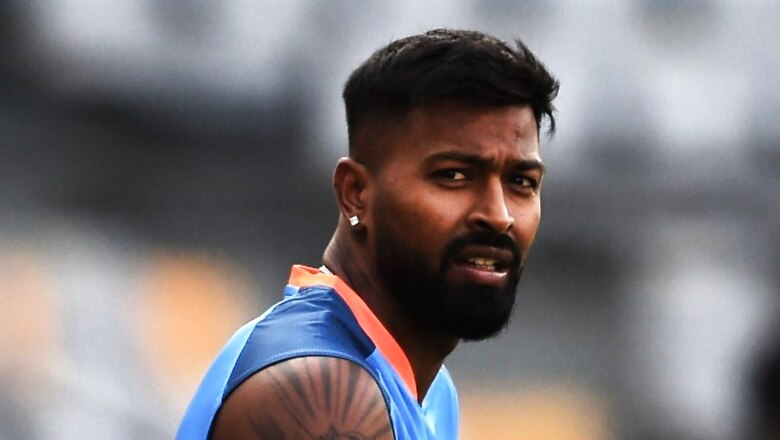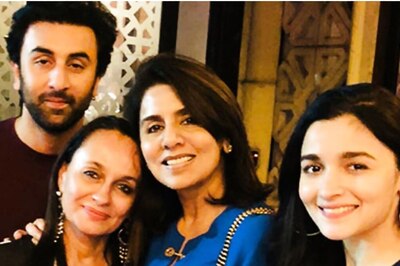
views
Sri Lanka were staring towards a certain defeat when debutant Shivam Mavi finished his quota of four overs that resulted in four wickets and just 22 runs. At 134/8 and 29 runs to win from two overs, Chamika Karunaratne and Kasun Rajitha had their task cut out.
Indian pacers had bowled their team into the winning position at the Wankhede Stadium with Mavi’s starring role being brilliantly backed by his captain Hardik Pandya (3-0-12-0), Umran Malik (4-0-27-2) and Harshal Patel (3-0-35-2).
Now, with two more quality overs of pace remaining, the script looked certainly titled heavily in favour of India.
Selectors Shuffle: Is Indian Cricket Ready to Bring in Fresh Energy?
Things then took a dramatic turn.
Pandya seemed to have hurt himself while taking a catch earlier in the match that forced him off the field for a brief period. Upon his return, he didn’t finish his quota having delivered three overs inside the Powerplay in what was an impressive spell.
He would later allay fears about his fitness, blaming his mid-match struggles on cramps.
In recent times, India have deployed either Bhuvneshwar Kumar or the young Arshdeep Singh to bowl the 19th over in T20Is. Neither of the two was playing this contest and hence Harshal was summoned.
He ended up leaking 16 runs in it.
The equation, on paper, did become a little palatable from Sri Lanka’s view. 13 from 6 but with just two wickets in the bank.
Pandya had an over remaining. Legspinner Yuzvendra Chahal had two but was expensive on the night having conceded 26 runs in two wicketless overs.
Left-arm spinner Axar Patel also had two overs left. He though fared better than Chahal conceding 21 in his first two overs.
Also Read: Laxman in Line to be Next Coach After Dravid’s Tenure
To an outsider, the choice to bowl the final over would have been obvious.
Right?
No.
Pandya had other plans. He asked Axar to defend the remaining 13 runs in a surprising call. Why? A gamble, maybe?
Or did Pandya not recover fully enough from the cramps forcing him to take the strange decision?
Whatever the reason, the die was cast.
As feared, the gamble seemed to be going wrong. Karunaratne brought down the equation to five off three after pulling one for a six, belted under high pressure.
A dot ball followed. Then a run out. And then another. Game over.
A two-run victory for India, a thrilling finish indeed.
As the team and the fans broke into celebrations, the decision to bring in Axar for the final over continued to stick out like a sore thumb.
Enquiries were made. And Pandya gave an interesting explanation.
“We might lose a game here and there but it’s alright. I want to put this team in difficult situations because it will help us in big games. (In) Bilaterals (series) we are very good at and this is how we are going to challenge ourselves,” Pandya said during the post-match presentation.
Pandya’s reasoning here makes a lot of sense.
Considering there’s little to nothing riding on these bilateral series, teams quite often use them to try out different things including giving chances to new players, testing team combinations and employing new strategies.
The aim behind such exercises is to find the best possible mixture that would help teams perform at their optimum level in major tournaments (read world cups).
And so is the case with India.
While surprises such as the one Pandya pulled out last night in Mumbai isn’t something out of the ordinary but it does give an indication that the 29-year-old is looking at the bigger picture: bringing the world cup home.
And for that, the plan has been set in motion. He wants his young team to be ready when the next T20 world cup rolls on in the Caribbean Islands-USA next year.
Pandya (provided he was fully fit) could have taken the safe route on Tuesday and bowled the final over himself considering how well things were going for him. Instead, he took a chance and gave the ball to Axar, asking him to deliver in a pressure situation.
By doing that, Pandya hopes that his players will get used to performing when the stakes are high which is nearly always the case in global events.
This isn’t the first time that Pandya has gone against the grain. Remember the Ireland tour last year – his first bilateral series as India captain?
Defending a mammoth total of 225 in the 2nd T20I during that tour, he asked newbie Umran Malik, playing in just his second match of international career, to bowl the final over of the Ireland chase in which the speedster had to defend 17 runs.
The circumstances were similar. Harshal had conceded 14 runs in the 19th over and with five wickets still in hand, Ireland were not out of the contest. Pandya had two overs left but he put his faith in Umran.
As it turned out, Mark Adair did belt a couple of fours off Umran but Ireland could only score 12 as India sealed a four-run win.
So, this is something that Pandya has been planning for long – long before he became the frontrunner to lead India, at least in T20Is.
And from Indian cricket’s perspective, these are exciting times – a captain who is ready to push himself and his teammates out of their comfort zones in addition to plenty of fearless youngsters knocking on the door and producing eye-catching performances.
Pandya surely has raised hopes.



















Comments
0 comment